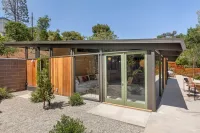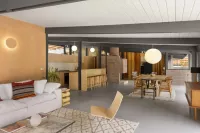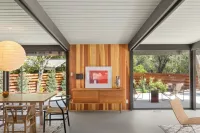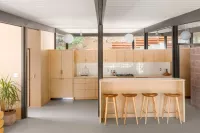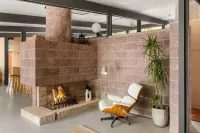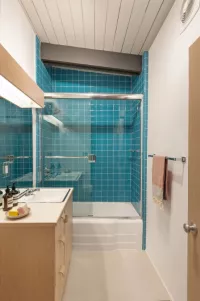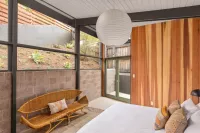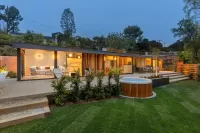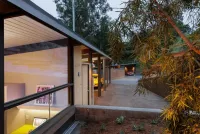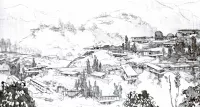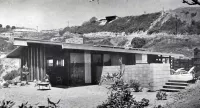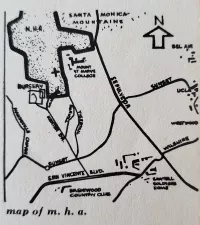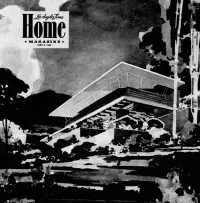Share what you know,
and discover more.
Share what you know,
and discover more.
Jun 06, 2023
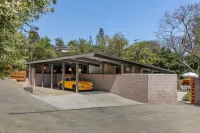
-

- Marley Zielike
Hart Residence, by architects A. Quincy Jones and Whitney R. Smith (1950)
From the listing agent: "Presenting the Hart Residence, by architects A. Quincy Jones and Whitney R. Smith (1950). An early example of the Mutual Housing Association homes of Crestwood Hills unique not only for its modernist architecture, but also for having been the only successful housing cooperative in the state of California. It was conceived of by four studio musicians returning from WWII, who devised a plan that would pool the resources of multiple owners to develop a community of modern homes. Fewer of the homes were built than originally envisioned, and unfortunately fewer still remain intact. One can thankfully now be added to the list of remaining homes. This was the latest project by HabHouse, which has built its reputation on sensitive rehabilitations of architectural properties. Each one is a labor of love- resurrecting a Los Angeles treasure that would have previously been considered lost to decades of ill-advised remodels and neglect. The distinctive sloping roofline with integral carport has been brought back, as have other attributes that this model and others in tract are known for: Douglas fir plywood built-ins, clear heart redwood tongue and groove siding, and exposed aggregate concrete block. The home was featured prominently in Julius Shulman's 1950 photography of the neighborhood demonstrating how the architects deftly oriented the siting of each house to maximize privacy. With this, extensive walls of glass are able to embrace the surrounding landscape and horizon view. The residence remains an example of idealism forged with modernism and holds a lasting place in Los Angeles history. This is a rare opportunity to become a part of that history and to live in a peaceful, one-of-a-kind setting." Photos by Cameron Carothers
Hart Residence, by architects A. Quincy Jones and Whitney R. Smith (1950)
From the listing agent: "Presenting the Hart Residence, by architects A. Quincy Jones and Whitney R. Smith (1950). An early example of the Mutual Housing Association homes of Crestwood Hills unique not only for its modernist architecture, but also for having been the only successful housing cooperative in the state of California. It was conceived of by four studio musicians returning from WWII, who devised a plan that would pool the resources of multiple owners to develop a community of modern homes. Fewer of the homes were built than originally envisioned, and unfortunately fewer still remain intact. One can thankfully now be added to the list of remaining homes. This was the latest project by HabHouse, which has built its reputation on sensitive rehabilitations of architectural properties. Each one is a labor of love- resurrecting a Los Angeles treasure that would have previously been considered lost to decades of ill-advised remodels and neglect. The distinctive sloping roofline with integral carport has been brought back, as have other attributes that this model and others in tract are known for: Douglas fir plywood built-ins, clear heart redwood tongue and groove siding, and exposed aggregate concrete block. The home was featured prominently in Julius Shulman's 1950 photography of the neighborhood demonstrating how the architects deftly oriented the siting of each house to maximize privacy. With this, extensive walls of glass are able to embrace the surrounding landscape and horizon view. The residence remains an example of idealism forged with modernism and holds a lasting place in Los Angeles history. This is a rare opportunity to become a part of that history and to live in a peaceful, one-of-a-kind setting." Photos by Cameron Carothers
Jun 06, 2023
Hart Residence, by architects A. Quincy Jones and Whitney R. Smith (1950)
From the listing agent:"Presenting the Hart Residence, by architects A. Quincy Jones and Whitney R. Smith (1950). An early example of the Mutual Housing Association homes of Crestwood Hills unique not only for its modernist architecture, but also for having been the only successful housing cooperative in the state of California.
It was conceived of by four studio musicians returning from WWII, who devised a plan that would pool the resources of multiple owners to develop a community of modern homes. Fewer of the homes were built than originally envisioned, and unfortunately fewer still remain intact. One can thankfully now be added to the list of remaining homes. This was the latest project by HabHouse, which has built its reputation on sensitive rehabilitations of architectural properties. Each one is a labor of love- resurrecting a Los Angeles treasure that would have previously been considered lost to decades of ill-advised remodels and neglect.
The distinctive sloping roofline with integral carport has been brought back, as have other attributes that this model and others in tract are known for: Douglas fir plywood built-ins, clear heart redwood tongue and groove siding, and exposed aggregate concrete block.
The home was featured prominently in Julius Shulman's 1950 photography of the neighborhood demonstrating how the architects deftly oriented the siting of each house to maximize privacy. With this, extensive walls of glass are able to embrace the surrounding landscape and horizon view. The residence remains an example of idealism forged with modernism and holds a lasting place in Los Angeles history. This is a rare opportunity to become a part of that history and to live in a peaceful, one-of-a-kind setting."
Photos by Cameron Carothers
Posted Date
Jul 20, 2023
Historical Record Date
Jun 06, 2023
Source Name
Dwell
Delete Story
Are you sure you want to delete this story?
Jul 01, 2021
Jul 01, 2021
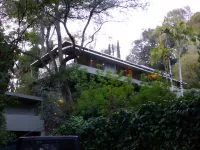
-

- Marley Zielike
Crestwood Hills - LA Conservancy
Overview In 1946, four musicians pooled their resources to form a cooperative housing group, which quickly grew to include 400 members and become known as the Mutual Housing Association (MHA). The group purchased 800 acres in the Santa Monica Mountains (an area later known as Crestwood Hills) and hired architects A. Quincy Jones and Whitney R. Smith and structural engineer Edgardo Contini. MHA was to become the only successful housing cooperative effort in California during the immediate postwar years, with acreage set aside for a park now owned by the City and a cooperative nursery school still operating today. The architects drew up twenty-nine house plans, many of them slight variations on nine different designs. The experimental, Modern-style designs boasted open plans with great expanses of glass creating an illusion of free-flowing space, extending the sight line to the property line. Building materials consisted of exposed concrete block, redwood siding, and Douglas Fir ceiling planks. Houses were oriented to respect the privacy of each individual house, often placed at a 45-degree angle to the street. This measure assured the proper scale for a neighborhood dependent on maintaining views over the rooftops of houses situated on lots below. These guidelines continue to set the neighborhood off from those that surround it. The high level of detail and the experimental nature of the designs raised the level of middle-income family housing, formerly reserved for the custom home. With the bravado characteristic of the immediate postwar period, MHA houses reflect an optimistic view to the future through modern design.
Crestwood Hills - LA Conservancy
Overview In 1946, four musicians pooled their resources to form a cooperative housing group, which quickly grew to include 400 members and become known as the Mutual Housing Association (MHA). The group purchased 800 acres in the Santa Monica Mountains (an area later known as Crestwood Hills) and hired architects A. Quincy Jones and Whitney R. Smith and structural engineer Edgardo Contini. MHA was to become the only successful housing cooperative effort in California during the immediate postwar years, with acreage set aside for a park now owned by the City and a cooperative nursery school still operating today. The architects drew up twenty-nine house plans, many of them slight variations on nine different designs. The experimental, Modern-style designs boasted open plans with great expanses of glass creating an illusion of free-flowing space, extending the sight line to the property line. Building materials consisted of exposed concrete block, redwood siding, and Douglas Fir ceiling planks. Houses were oriented to respect the privacy of each individual house, often placed at a 45-degree angle to the street. This measure assured the proper scale for a neighborhood dependent on maintaining views over the rooftops of houses situated on lots below. These guidelines continue to set the neighborhood off from those that surround it. The high level of detail and the experimental nature of the designs raised the level of middle-income family housing, formerly reserved for the custom home. With the bravado characteristic of the immediate postwar period, MHA houses reflect an optimistic view to the future through modern design.
Crestwood Hills - LA Conservancy
OverviewIn 1946, four musicians pooled their resources to form a cooperative housing group, which quickly grew to include 400 members and become known as the Mutual Housing Association (MHA). The group purchased 800 acres in the Santa Monica Mountains (an area later known as Crestwood Hills) and hired architects A. Quincy Jones and Whitney R. Smith and structural engineer Edgardo Contini. MHA was to become the only successful housing cooperative effort in California during the immediate postwar years, with acreage set aside for a park now owned by the City and a cooperative nursery school still operating today.
The architects drew up twenty-nine house plans, many of them slight variations on nine different designs. The experimental, Modern-style designs boasted open plans with great expanses of glass creating an illusion of free-flowing space, extending the sight line to the property line. Building materials consisted of exposed concrete block, redwood siding, and Douglas Fir ceiling planks. Houses were oriented to respect the privacy of each individual house, often placed at a 45-degree angle to the street.
This measure assured the proper scale for a neighborhood dependent on maintaining views over the rooftops of houses situated on lots below. These guidelines continue to set the neighborhood off from those that surround it. The high level of detail and the experimental nature of the designs raised the level of middle-income family housing, formerly reserved for the custom home. With the bravado characteristic of the immediate postwar period, MHA houses reflect an optimistic view to the future through modern design.
Posted Date
Jul 20, 2023
Historical Record Date
Jul 01, 2021
Source Name
Los Angeles Conservancy
Source Website
Delete Story
Are you sure you want to delete this story?
Mar 16, 2016
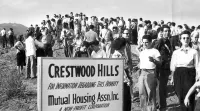
-

- Marley Zielike
Behind Brentwood: How the Crestwood Hills Park Emerged
Behind Brentwood: How the Crestwood Hills Park Emerged By Cory Buckner On a hillside in the Brentwood area of Los Angeles, the Mutual Housing Association (MHA) broke ground for its residential dream on October 5, 1947. Crestwood Hills, formerly MHA, was to become the only successful large-scale modern housing cooperative in the West. Architects A. Quincy Jones and Whitney R. Smith, and structural engineer Edgardo Contini – all steeped in the ethos of Southern California modernist architecture – were selected as the design team. They provided a selection of more than 20 innovative designs for 350 small lots. A large flat area was designated for the cooperative services, which included a park, clubhouse, nursery school, gas station, a variety store, swimming pool, amphitheater, and an administration building to house medical services and credit union activities. But idealism met harsh reality when two contractors went bankrupt building the structures. Eventually only 85 of the MHA houses and the preschool were completed. The ambitious plans for a cooperative utopia began to fade and several day camps began using the acreage that was designated for the park. Founding members Sharon Leonard and Marge Bonderman decided they had better establish a park facility before it was taken over by other users. Organizing their own day camp, a group of Crestwood Hills mothers reclaimed the park for the community. Addressing a need for more equipment and expert supervision, they collected $10 from each Crestwood Hills family. The Los Angeles City officials were approached and agreed to supply a park director in exchange for the funds collected and included a swing set and slide, as well as other equipment. A deserted contractor’s shack was moved to the park area and it became the first clubhouse. Close to 30 children, including Leonard’s four boys, used the little clubhouse. With more people moving into the area, the group approached the City to take responsibility for the park since it had become more than the community members could manage. The land was given to the City in 1961 to maintain as a park. Residents Marvin Braude, the future County supervisor; Ray Siegal, one of the four original founders of MHA; and Leonard pitched to the City the idea of building a clubhouse, which resulted in $30,000 granted towards construction of the structure. A. Quincy Jones and his partner Frederick E. Emmons designed the clubhouse with community input. The facility included a small amphitheater facing a moveable wall. With the wall opened, the space provided ample room for concerts, plays, and performances. A grand piano was donated for the space and Fritz Feld, the character actor and Crestwood resident, lured musicians, dancers, and other artists to perform for the community. The amphitheater was later named the Fritz Feld Theater in his honor. Carnivals were held every year with the City supplying the booths and a spook house at Halloween. Neighborhood potluck picnics were a common event for all of the holidays, including the 4th of July, but eventually many of the founding members aged out of the community and the clubhouse and park were seldom used. It wasn’t until the early 1990s, when a new generation of families began moving into the community, that the need to revitalize the park became apparent. The park activities kept the community cohesive until several years ago when cuts in the City budget eliminated the park director and closed the clubhouse for all but two days a week. Today, the increased use created by the new preschool director, Joanna Port, combined with the needs of the community have resulted in a new energy at the park and a fulltime park director, Mark Wilson. Once again, the park has become a magnet to unite the community within a beautiful natural setting. Photos from the Mutual Housing Association archives
Behind Brentwood: How the Crestwood Hills Park Emerged
Behind Brentwood: How the Crestwood Hills Park Emerged By Cory Buckner On a hillside in the Brentwood area of Los Angeles, the Mutual Housing Association (MHA) broke ground for its residential dream on October 5, 1947. Crestwood Hills, formerly MHA, was to become the only successful large-scale modern housing cooperative in the West. Architects A. Quincy Jones and Whitney R. Smith, and structural engineer Edgardo Contini – all steeped in the ethos of Southern California modernist architecture – were selected as the design team. They provided a selection of more than 20 innovative designs for 350 small lots. A large flat area was designated for the cooperative services, which included a park, clubhouse, nursery school, gas station, a variety store, swimming pool, amphitheater, and an administration building to house medical services and credit union activities. But idealism met harsh reality when two contractors went bankrupt building the structures. Eventually only 85 of the MHA houses and the preschool were completed. The ambitious plans for a cooperative utopia began to fade and several day camps began using the acreage that was designated for the park. Founding members Sharon Leonard and Marge Bonderman decided they had better establish a park facility before it was taken over by other users. Organizing their own day camp, a group of Crestwood Hills mothers reclaimed the park for the community. Addressing a need for more equipment and expert supervision, they collected $10 from each Crestwood Hills family. The Los Angeles City officials were approached and agreed to supply a park director in exchange for the funds collected and included a swing set and slide, as well as other equipment. A deserted contractor’s shack was moved to the park area and it became the first clubhouse. Close to 30 children, including Leonard’s four boys, used the little clubhouse. With more people moving into the area, the group approached the City to take responsibility for the park since it had become more than the community members could manage. The land was given to the City in 1961 to maintain as a park. Residents Marvin Braude, the future County supervisor; Ray Siegal, one of the four original founders of MHA; and Leonard pitched to the City the idea of building a clubhouse, which resulted in $30,000 granted towards construction of the structure. A. Quincy Jones and his partner Frederick E. Emmons designed the clubhouse with community input. The facility included a small amphitheater facing a moveable wall. With the wall opened, the space provided ample room for concerts, plays, and performances. A grand piano was donated for the space and Fritz Feld, the character actor and Crestwood resident, lured musicians, dancers, and other artists to perform for the community. The amphitheater was later named the Fritz Feld Theater in his honor. Carnivals were held every year with the City supplying the booths and a spook house at Halloween. Neighborhood potluck picnics were a common event for all of the holidays, including the 4th of July, but eventually many of the founding members aged out of the community and the clubhouse and park were seldom used. It wasn’t until the early 1990s, when a new generation of families began moving into the community, that the need to revitalize the park became apparent. The park activities kept the community cohesive until several years ago when cuts in the City budget eliminated the park director and closed the clubhouse for all but two days a week. Today, the increased use created by the new preschool director, Joanna Port, combined with the needs of the community have resulted in a new energy at the park and a fulltime park director, Mark Wilson. Once again, the park has become a magnet to unite the community within a beautiful natural setting. Photos from the Mutual Housing Association archives
Mar 16, 2016
Behind Brentwood: How the Crestwood Hills Park Emerged
Behind Brentwood: How the Crestwood Hills Park EmergedBy Cory Buckner
On a hillside in the Brentwood area of Los Angeles, the Mutual Housing Association (MHA) broke ground for its residential dream on October 5, 1947. Crestwood Hills, formerly MHA, was to become the only successful large-scale modern housing cooperative in the West. Architects A. Quincy Jones and Whitney R. Smith, and structural engineer Edgardo Contini – all steeped in the ethos of Southern California modernist architecture – were selected as the design team. They provided a selection of more than 20 innovative designs for 350 small lots. A large flat area was designated for the cooperative services, which included a park, clubhouse, nursery school, gas station, a variety store, swimming pool, amphitheater, and an administration building to house medical services and credit union activities.
But idealism met harsh reality when two contractors went bankrupt building the structures. Eventually only 85 of the MHA houses and the preschool were completed. The ambitious plans for a cooperative utopia began to fade and several day camps began using the acreage that was designated for the park.
Founding members Sharon Leonard and Marge Bonderman decided they had better establish a park facility before it was taken over by other users. Organizing their own day camp, a group of Crestwood Hills mothers reclaimed the park for the community. Addressing a need for more equipment and expert supervision, they collected $10 from each Crestwood Hills family. The Los Angeles City officials were approached and agreed to supply a park director in exchange for the funds collected and included a swing set and slide, as well as other equipment.
A deserted contractor’s shack was moved to the park area and it became the first clubhouse. Close to 30 children, including Leonard’s four boys, used the little clubhouse. With more people moving into the area, the group approached the City to take responsibility for the park since it had become more than the community members could manage. The land was given to the City in 1961 to maintain as a park. Residents Marvin Braude, the future County supervisor; Ray Siegal, one of the four original founders of MHA; and Leonard pitched to the City the idea of building a clubhouse, which resulted in $30,000 granted towards construction of the structure.
A. Quincy Jones and his partner Frederick E. Emmons designed the clubhouse with community input. The facility included a small amphitheater facing a moveable wall. With the wall opened, the space provided ample room for concerts, plays, and performances. A grand piano was donated for the space and Fritz Feld, the character actor and Crestwood resident, lured musicians, dancers, and other artists to perform for the community. The amphitheater was later named the Fritz Feld Theater in his honor.
Carnivals were held every year with the City supplying the booths and a spook house at Halloween. Neighborhood potluck picnics were a common event for all of the holidays, including the 4th of July, but eventually many of the founding members aged out of the community and the clubhouse and park were seldom used.
It wasn’t until the early 1990s, when a new generation of families began moving into the community, that the need to revitalize the park became apparent. The park activities kept the community cohesive until several years ago when cuts in the City budget eliminated the park director and closed the clubhouse for all but two days a week.
Today, the increased use created by the new preschool director, Joanna Port, combined with the needs of the community have resulted in a new energy at the park and a fulltime park director, Mark Wilson. Once again, the park has become a magnet to unite the community within a beautiful natural setting.
Photos from the Mutual Housing Association archives
Posted Date
Jul 20, 2023
Historical Record Date
Mar 16, 2016
Source Name
Brentwood News
Source Website
Delete Story
Are you sure you want to delete this story?


